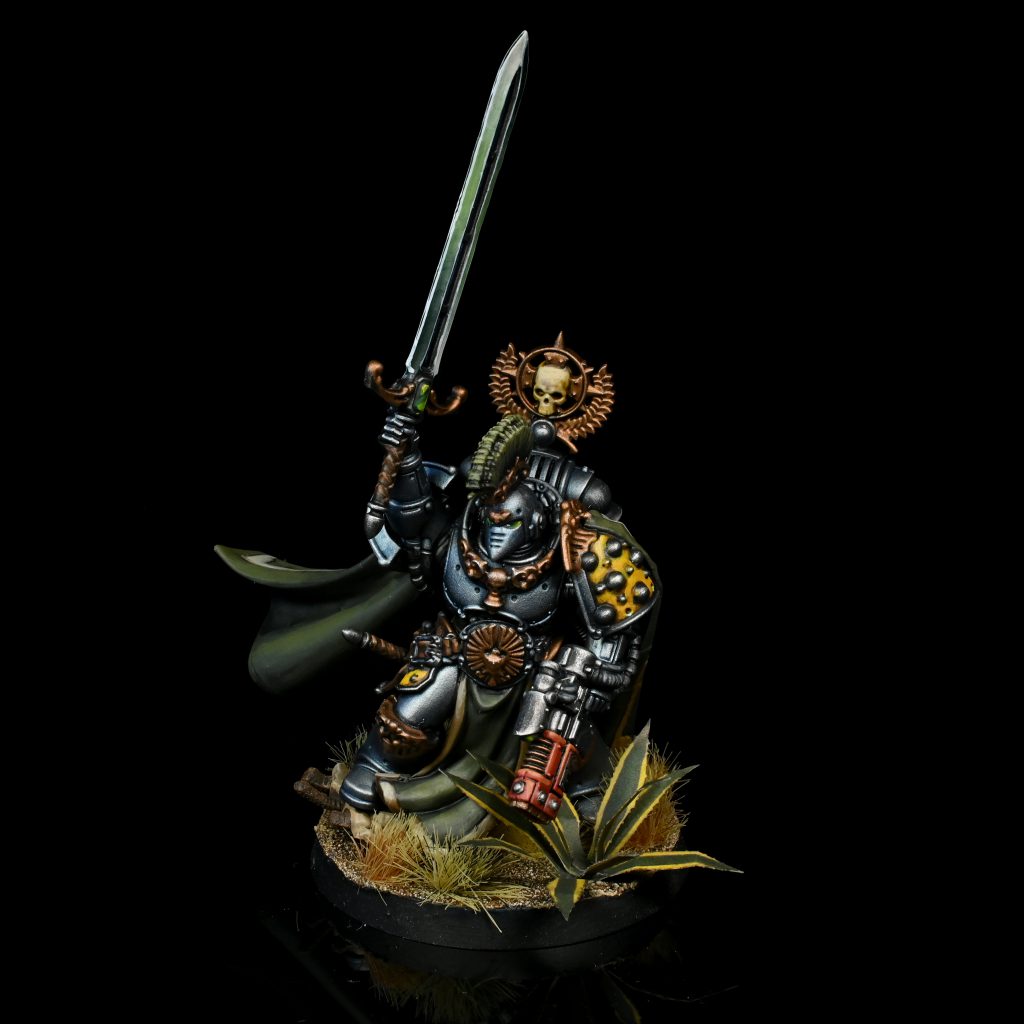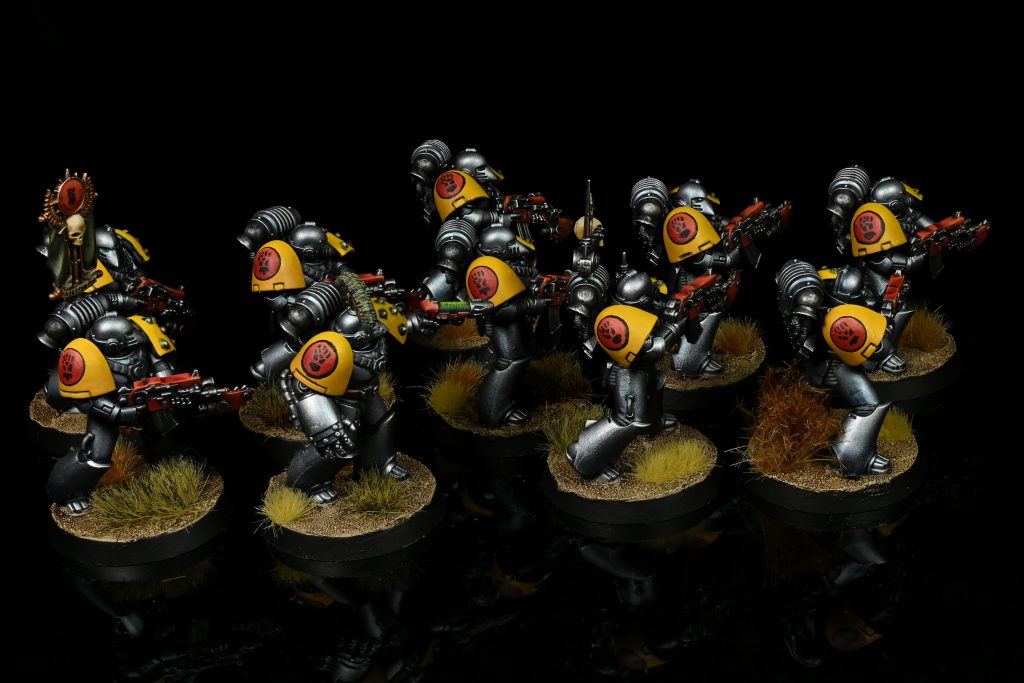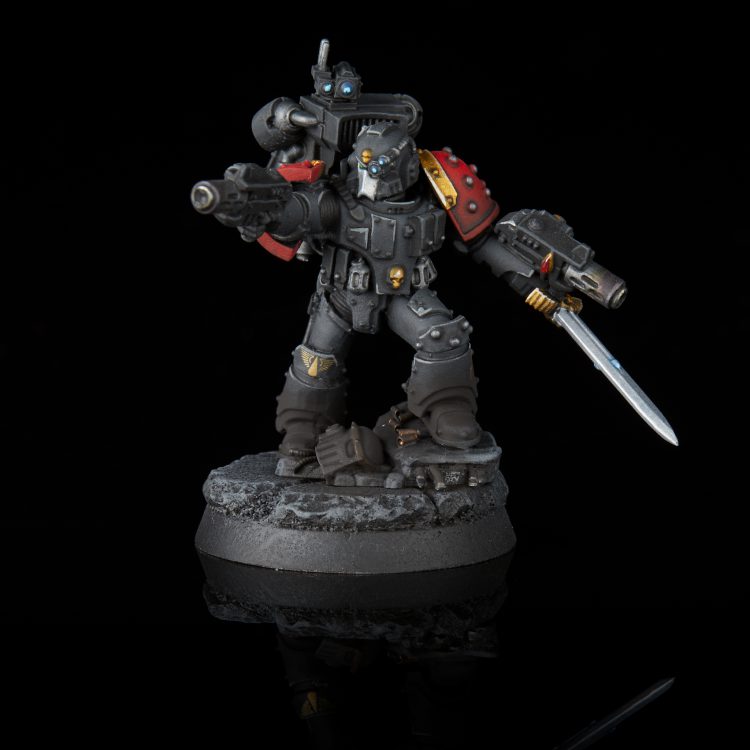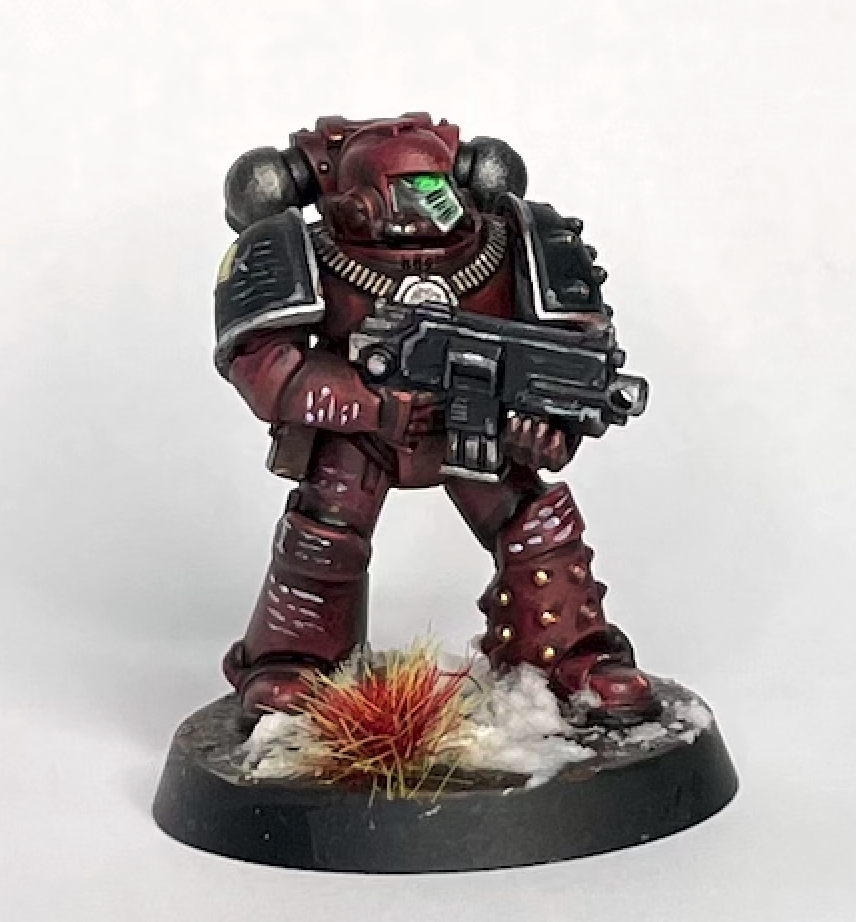In this instalment of How to Paint Everything, we’ll be looking at the thorny issue of infantry heraldry in the Age of Darkness: where does it go, what should it look like, and how on earth do I make sure that it looks good? We won’t be covering vehicles, dreadnoughts, banners or other aspects of heraldry in this article – there’s enough to be talking about just with power armour.
Before we go any further, let’s get the most important thing out of the way: it doesn’t matter. The Horus Heresy was a galactic conflict involving millions of soldiers, hundreds of thousands of Space Marines, and tens of thousands of enormous battles. The legions were vast and included dozens of Chapters, each often forming its own particular heraldic tics and cultures, and there was almost no consistency across legions, let alone between them. You can go absolute buckwild with your heraldry (and maybe check out our HTPE: Heraldry article for more general ideas about it) and anyone who says you’re doing it wrong needs to touch grass.

Praetor. Credit: RockfishThat out of the way, let’s plunge into the easiest ways of doing it “right”. By right I mean in line with the materials we have available to us, and with some easy tricks for consistency that makes things easier to manage. The 2nd edition has actually tidied this up a little for us, so there’s more consistency between and within legions (if you want there to be), but there are some problems that arise! Lots of the colour plates in the books used to demonstrate this stuff are on a specific mark of power armour, and not all marks of power armour can have this heraldry applied in the same way. Let’s dive in.
Heraldic Markings
There are a huge number of different markings and heraldic devices used in the Horus Heresy, so it’s worth us just breaking them down into their categories and talking about what they are right away.
Armourials
Amourials are the most common devices you’ll see on power armour. These are armour markings that designate the Marine as belonging to a specific organisation or group.
There’s usually a specific marking for each legion (the winged blood drop for Blood Angels, the hydra of the Alpha Legion, and so on) which is used on many Marines, and is called a Legion Armourial. There’s a standard version for each legion, but then there are some variations. Most legions have a Line Officer Variant (usually with additional ornamentation or a different colour scheme) which is used to designate line officers (Centurions and other officers that fight with the front line). There are also some other variant armourials in some legions, such as for particular rites, lodges, and other internal organisations that cut across formal lines of command and tactical designations.

Some Marines may also be spotted with an Archaic Legion Armourial. This is generally a device that was, at one point, the official armourial of the legion, but has since been supplanted by a new standard. There are lots of reasons that Marines might still carry these. Some veterans carry them to show off their seniority; others to show their loyalty to an earlier culture or ethos within the legion; while others simply use it as part of the local culture of their chapter or company. The most common archaic legion armourials are legion numbers: roman numerals of the legion in question (these are more properly known as Legion Ordina). You’ll see legion numberings come up in other devices as well, but having them instead of the standard Legion Armourial isn’t uncommon. Some legions may also have other devices that were previously in use (such as the Alpha Legion’s Alpha-Omega with chain device).
Some legions also will use Chapter Armourials or similar instead (or as well) as a legion one. Each chapter within a legion is roughly 1000 Marines strong, and often fights as an independent group in the Heresy, forming its own culture and approach to war. As such, many of them adopt their own rituals, markings and even armourials. This is more common in some legions than others, with legions like the Word Bearers often sporting devices other than the legion armourial, while in others it’s much less common. These devices are usually based to some extent on the standard legion marking, but they can truly be anything so feel free to embrace your inner artist for these. Many of the chapters of Marines that were formed after the Codex Astartes was implemented were drawn from chapters of the legions that preceded them, so using a later chapter marking is absolutely valid in this period. Some legions might have other types of subdivision in their armourials – a good example is the Dark Angels and the wing armourials commonly seen on their forces.
Rank and Role Markings
The other kind of marking on armour that’s extremely common is the Rank and Role Marking which is a symbol (or set of symbols) that indicates what kind of unit the Marine is a part of and what rank they hold within it. Not all Marines sport these and they come in many different variations but they do broadly follow some rough guidelines.
The majority of legions use something close to the roles laid out in the Liber Armourium Terranicus, the legions’ guide to armour markings and symbols. How much of them they use, and how closely they cleave, varies considerably with legions like the Imperial Fists being known to hold to them relatively rigidly, while legions like the Space Wolves vary wildly from them.
There are six role markings common to the Liber with one more having evolved over the Great Crusade and in common use.
- Tactical Line Units usually bear an upwards pointing arrow or two horizontal arrows pointing away from each other. Some legions have been known to use both, sometimes seemingly randomly while other times to indicate standard line infantry (upward arrow) and mechanised infantry (horizontal arrows). Others use stylised or altered versions of these symbols such as the Raven Guard bisected circle.

- Rapid Attack Units are noted by their crossed double-ended arrows to form an X shape. This is one of the most consistent armour markings thought some legions still use variants (like the Raven Guard quartered circle).
- Fire Support Units use a Lambda (an upturned V) as a designation, though some legions use variations on this. A small number of legions use a different designation (a blast symbol) for these units.
- Elite Units use a stylised Greek cross (with all arms of equal lengths) that is generally adorned in some way to the flavour and culture of the legion. For example, the Imperial Fists use a Maltese Cross, while the Raven Guard use something more like a Cross of Jerusalem.
- Recon Units are often fielded without designated markings, but for legions with many of them or where their role is more scouting rather than deniable tactics they are usually marked with a lightning bolt.
- Command Units use either a skull, lightning bolt or wreath around the legion armourial to designate their role. This the most varied because it tends to reflect most strongly the culture of the legion.
- Destroyer Squads are the unit that gained a designation during the Great Crusade as their use became more widespread. These generally carry the three pronged device that indicates hazardous materials or radiation in the 31st millennium, as well as often being adorned with a skull or other warning markings. This designation almost always is presented in a variant colour scheme (while for other role markings they can but are usually on standard armour colours), making clear the specific and dangerous role they have.

Some legions also have marked for other roles known as Variant Role Markings such as for breacher squads and other specialist units. These are as varied as the roles and legions that include them, but usually replace the standard role marking.
Beyond these role markings, rank is often also marked either alongside the role marking or elsewhere. An upturned chevron, sometimes with extended arms, enclosing the role marking is the most common rank marking though wreathes for more senior officers in a particular role isn’t uncommon.
Organisational Markings
Beyond their chapter, Space Marines were organised into companies, task forces, campaigns, armies and many other organisational groupings. These often had markings of their known, generally referred to as organisational markings. The most common of these are company markings which might have specific insignia, or might just have an ordinal. Company Ordinals are usually not included alongside legion ordinals simply to reduce confusion in the field.
Beyond this markings like Army Badges can be seen commonly, designating the Marine as part of a larger organisational structure. You might also see Campaign Badges but these are distinct from honours and this can sometimes be confusing.
Honours
Beyond markings that have certain utility, Space Marines (like many soldiers throughout history) often bear Honours on their armour to commemorate important deeds, campaigns they fought in, or particular achievements.
Campaign Honours are one of the most common, indicating their veterancy of a particular campaign or battle. One of the most common is the Terran Raptor which was granted to those who are veterans of the Unification Wars.
There are also general Honour Markings that are painted or embossed onto armour and granted for exceptional acts of bravery or achievement. These are something like medals, and usually granted by a senior officer for specific actions. These are almost always legion-specific in appearance, incorporating elements of the legion armourials with specific flourishes or embellishments to make clear the exceptional circumstances of their awarding.
Some legions also have particular cultural honours that are not shared with others. An example of this are the Dark Angels Oaths of Moment which are pledges of action and deed born on the armour to win honour. Various other pledges, rites, runes, and ornamentations might be added to show dedication, determination and honour in battle.
Marking Placement
Where these markings go varies considerably between legions, companies, chapters and even individual Marines as different parts of their armour need field modifications and repairs. However, there are certain standard practices and approaches depending on the mark and type of armour used, as well as general principles.

As a rule of thumb markings are placed as follows:
- The Helmet is used to designate veteran status and rank. Line infantry tends to have few adornments, while veterans will have a mark, stripe or other splash of colour to show their status. Sergeants generally have a different marking (often a centre stripe going down the middle of the helmet) to indicate their rank. Veteran sergeants either combine these markings, or invert the colours of the sergeant marking. Few Marines have specific heraldic devices on their helms themselves, though this is more common with line officers and legion officers (who often have crests – transverse for line officers, forward for legion officers – or plumes).
- The Left Shoulder Pad is used in most marks of armour for the Legion Armourial, or whatever alternative armourial is selected
- The Right Shoulder Pad is commonly used for the Role and Rank Marking, though this may be rendered small in one corner with the main bulk of the pad used for a second Armourial.
- The Forearms can be used for Role and Rank Markings, Honours or Legion Ordina depending on the legion and marine. They are rarely, but sometimes, used for Company Ordina and other such organisational markings.
- The Chestplate is the common location for Honours so they can be seen clearly and distinctly. This is where the most impressive and significant Campaign Honours as well as other honour markings are placed.
- The Kneepads are most commonly used for Legion Ordina or Company Ordina, though honour markings and organisational markings aren’t uncommon either.
- The Shins are generally used for ornamentation and little else.
This rough schemata works well for most marks of armour (including Terminator armour), but Mark VI power armour has a studded left shoulder pad that cannot be used for markings, and so some changes are required in this case. In most cases the Armourial is switched to the right pad, and then the Role and Rank Markings are moved either to the right forearm or the right shin (as the armour lacks kneepads).
Applying your Heraldry
Now you have a better understanding of what heraldic markings are common on power armour and where they are likely to go, the question is: how do you apply them? There a few different approaches.
Games Workshop and Forge World (as well as many third party sellers) sell a number of sculpted shoulder pads with insignia already cast into the shape of the piece. These are great looking in many cases and certainly making painting them up easier, but it’s very hard to introduce any variation or changes, and of course it only helps with the markings on the pads themselves. Generally only the Legion Armourial is included in these pads as well, as you’ll need to deal with role and rank markings and other such things another way.
Another common option is to apply transfers. You can buy legion transfers for each of the legions from Games Workshop, and though they are expensive they’re exceptionally good quality and give you a great assortment of different markings to apply to your Marines. You can find our complete guide to working with decals and transfers elsewhere on the site, but one thing to consider when going down this road is exactly how much this will cost and how many decals you will need or want. You don’t have to apply heraldry consistently or to every Marine, but if you’re going to you’re likely going to need two or three of those sheets for a full army, and that adds up. A cheaper alternative is to buy or get hold of some of the 40k transfer sheets, as those will have a lot of the role markings and most of them can be used without tweaks, or with small alterations with a brush after application. If you’re playing Imperial Fists or Sons of Horus, of course, you’re very much in luck as those are the ones on the default transfer sheets that are supplied with the kits, and so there will be a flood of those available on the secondary market.

The final way is of course to do them by hand yourself. This is the most difficult and time consuming way of approaching it, but you can really customise every Marine in the way you want. You can get some tips from our article on painting heraldic details, but your best bet is to plan where you want everything to go, get a nice brush with a sharp tip, and then just practice until you get it right. At the very least, by the time you’ve done your 80th Marine you’ll be much much better at it than when you started.


